
The Organisation armée secrète was a far-right French dissident paramilitary and terrorist organisation during the Algerian War. The OAS carried out terrorist attacks, including bombings and assassinations, in an attempt to prevent Algeria's independence from French colonial rule. Its motto was L’Algérie est française et le restera.
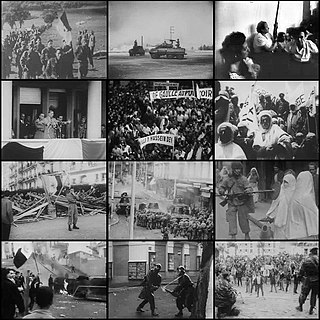
The Algerian War was a major armed conflict between France and the Algerian National Liberation Front (FLN) from 1954 to 1962, which led to Algeria winning its independence from France. An important decolonization war, it was a complex conflict characterized by guerrilla warfare and war crimes. The conflict also became a civil war between the different communities and within the communities. The war took place mainly on the territory of Algeria, with repercussions in metropolitan France.

French Algeria, also known as Colonial Algeria, was the period of Algerian history when the country was a colony and later an integral part of France.
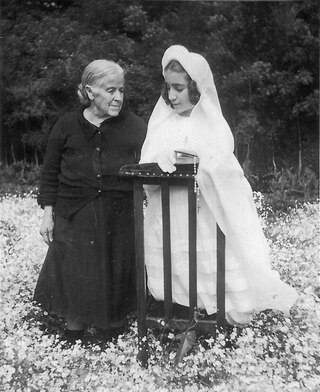
The pieds-noirs are an ethno-cultural group of people of French and other European descent who were born in Algeria during the period of French rule from 1830 to 1962. Many of them departed for mainland France during and after the war by which Algeria gained its independence in 1962.

Harki is the generic term for native Muslim Algerians who served as auxiliaries in the French Army during the Algerian War from 1954 to 1962. The word sometimes applies to all Algerian Muslims who supported French Algeria during the war. The motives for enlisting were mixed. They are regarded as traitors in independent Algeria and tens of thousands of them were killed after the war in reprisals despite the Évian Accords ceasefire and amnesty stipulations. President Charles de Gaulle controversially made the decision to not give the Harkis sanctuary in France, viewing them as "soldiers of fortune" who should be gotten rid of as soon as possible.
The Évian Accords were a set of peace treaties signed on 18 March 1962 in Évian-les-Bains, France, by France and the Provisional Government of the Algerian Republic, the government-in-exile of FLN, which sought Algeria's independence from France. The Accords ended the 1954–1962 Algerian War with a formal cease-fire proclaimed for 19 March and formalized the status of Algeria as an independent nation and the idea of cooperative exchanges between the two countries.

The Sétif and Guelma massacre was a series of attacks by French colonial authorities and pied-noir European settler militias on Algerian civilians in 1945 around the market town of Sétif, west of Constantine, in French Algeria. In response to French police firing on demonstrators at a protest on 8 May 1945, riots in the town were followed by attacks on French settlers (colons) in the surrounding countryside, resulting in 102 deaths. The French colonial authorities and European settlers retaliated by killing between 6,000 and 45,000 Muslims in the region. Both the outbreak and the indiscriminate nature of its retaliation marked a turning point in Franco-Algerian relations, leading to the Algerian War of 1954–1962.
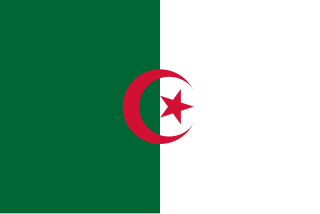
The National Liberation Army or ALN was the armed wing of the nationalist National Liberation Front of Algeria during the Algerian War. After Algeria won its independence from France in 1962, the ALN was converted into the regular Algerian People's National Armed Forces.
The Oran massacre of 1962 was the mass killing of Pied-Noir and European expatriates living in Algeria. It took place in Oran beginning on the date of Algerian independence, and ended on 7 July 1962. Estimates of the casualties vary from a low of 95 to 365 deaths in a report by a group of historians sent to the French government in 2006, and have been utilised by right-wing parties.
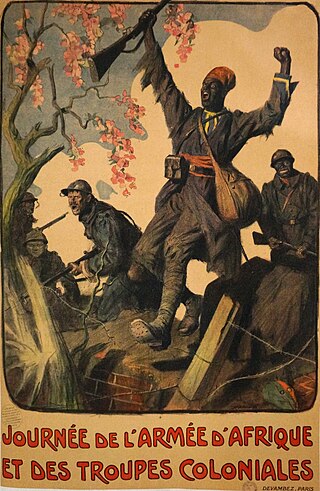
The Army of Africa was an unofficial but commonly used term for those portions of the French Army stationed in French North Africa from 1830 until the end of the Algerian War in 1962, including units made up of indigenous recruits.

Bab El Oued is a neighbourhood in Algiers, the capital of Algeria, along the coast north of the city centre. As of 2008, the population of the commune of Bab El Oued was 64,732.
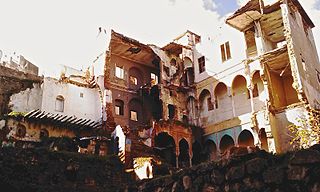
The Battle of Algiers was a campaign fought during the Algerian War. It consisted of urban guerrilla warfare and terrorist attacks carried out by the National Liberation Front (FLN) against the French authorities in Algiers, and by the French authorities, army, and French terrorist organizations against the FLN. Both sides targeted civilians throughout the battle. The conflict began with attacks by the FLN against the French forces and Pieds-Noirs followed by a terrorist attack on Algerian civilians in Algiers by a group of settlers, part of the terrorist group "La Main Rouge", aided by the police. Reprisals followed and the violence escalated, leading the French Governor-General to deploy the French Army in Algiers to suppress the FLN. Civilian authorities gave full powers to General Jacques Massu who, operating outside legal frameworks between January and September 1957, eliminated the FLN from Algiers. The use of torture, forced disappearances and illegal executions by the French later caused controversy in France.

Relations between France and Algeria span more than five centuries. This large amount of time has led to many changes within the nation of Algeria; subsequently, affecting the relations enormously. Through this time period, Algeria has gone through being part of the Ottoman Empire, being conquered and colonized by France, playing an important role in both world wars, and finally being its own nation. Over time, relations between the nations have suffered, as tension between Algerians and the French have increased.
The Battle of Agounennda was an engagement of the Algerian War fought from the 23–25 May 1957 between the French 3rd Colonial Parachute Regiment under Lieutenant Colonel Marcel Bigeard and FLN’s Commando 41 under Si Azzedine. Bigeard and his regiment were sent to hunt down the Commando after it had carried out several successful ambushes against French units. They met at Agounennda where the French paratroopers tried to ambush the FLN force, but the FLN discovered the French and instead concentrated their force against an outlying French company.
The Battle of Philippeville, also known as the Philippeville massacre or the August Offensive was a series of raids launched on 20 August 1955 on various cities and towns of the Constantine region by FLN insurgents and armed mobs during the Algerian War between France and Algerian rebels. The raids, which mostly took the form of ethnic riots, resulted in the massacre of several dozens of European settlers known as Pieds-Noirs. These massacres were then followed by reprisals by the French army and Pieds-Noirs vigilantes, which resulted in the death of several thousand Muslim Algerians. The events of late August 1955 in the Constantinois region are considered to be a major turning point of the Algerian War.
During the French colonial period (1830–1962), Algeria contained a large European population of 1.6 million who constituted 15.2% of the total population in 1962. Consisting primarily of French people, other populations included Spaniards in the west of the country, Italians and Maltese in the east, and other Europeans in smaller numbers. Known as Pieds-Noirs, European colonists were concentrated on the coast and formed a majority of the population of Oran (60%) and important proportions in other large cities like in the capital Algiers and Bône. In religion, they were mostly Roman Catholic Christians. In 1871, the indigenous Jews obtained the French nationality, and they were also considered as pieds noirs.

The Battle of Bab el Oued was a violent confrontation which occurred during the latter stages of the Algerian War (1954–1962) between the French Army and the Organisation armée secrète (OAS) which opposed Algerian independence. It took place in Bab El Oued, then a working-class European quarter of Algiers, from 23 March to 6 April 1962.
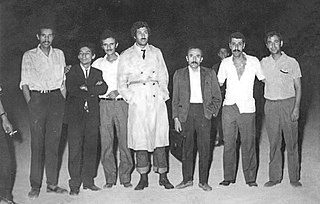
Yahia Benmabrouk (1928–2004) was an Algerian comedian and film actor, born on March 30 on 1928 in Algiers and died on October 8, 2004, in Bab El Oued.
Independence Day, observed annually on 5 July, is a National Holiday in Algeria commemorating colonial Algerian independence from France on 5 July 1962.
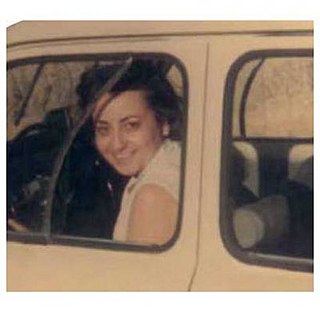
Eveline Safir Lavalette was an Algerian Pied-Noir revolutionary and activist during the Algerian War of Independence. She was born in 1927 in Rouïba. In 1951, she became active in the Algerian Youth Association for Social Action, and became an anti-poverty crusader. This began her interest in political affairs. She joined the National Liberation Front (Algeria) as an officer, distributing pamphlets and assisting with the publication of the Front's underground newspaper, El Moudjahid. She is famous for her arrest by French colonial forces in 1956, as documented in her autobiographical text Juste Algérienne: Comme une tissure. She was imprisoned and tortured until 1959, when she was released.














